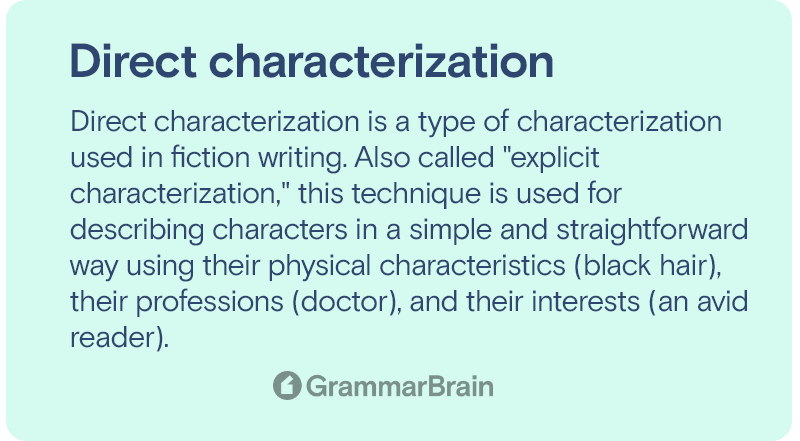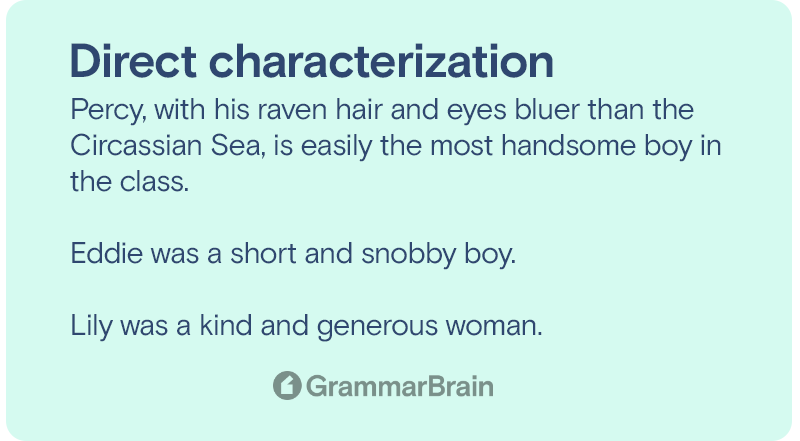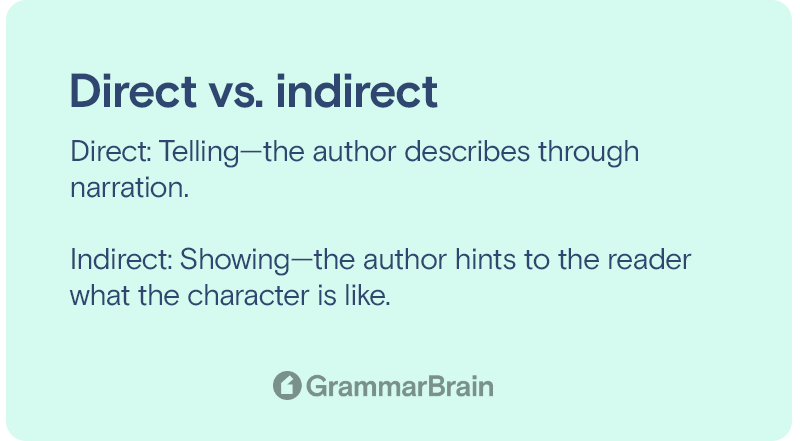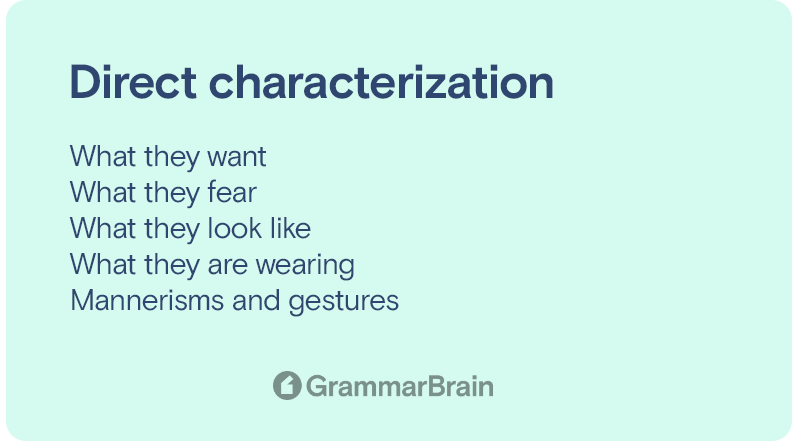What is direct characterization? Characterization is most commonly used in friction writing. It’s employed to help writers depict a visual in a straightforward and comprehendible fashion. Learn everything you need to know about direct characterization in this complete guide.

What is direct characterization?
Characterization refers to the process of describing the physical traits, personality, thoughts, and actions of a character. Direct characterization is a type of characterization used in fiction writing. Also called “explicit characterization,” this technique is used for describing characters in a simple and straightforward way using their physical characteristics (black hair), their professions (doctor), and their interests (an avid reader). This is an effective and widely used literary device.

Example:
- Percy, with his raven hair and eyes bluer than the Circassian Sea, is easily the most handsome boy in the class.
- Eddie was a short and snobby boy.
- Lily was a kind and generous woman.
Why is direct characterization is so important?
Direct characterization aids readers in creating a nearly accurate mental image of the character they are reading about.
Though good authors often urge their readers to form their own characterization, sometimes a plot point may heavily depend on a physical attribute or some other quality of the character.
In this case, giving an accurate description of the character becomes crucial to the plot of the story.
For example, in the Harry Potter series, the physical attributes and charming nature of the antagonist, Voldemort, were instrumental in his manipulation of other gullible characters in the story. This makes it necessary for the author to employ direct characterization.

When is using direct characterization appropriate?
In the English language, direct characterization is frequently used to establish crucial details and provide background information about characters, such as their profession or primary motivations, during their initial introduction.
After this introduction is made, the reader can continue reading with an almost clear understanding of the character’s identity.
An author can use direct characterization at any time while the work is in progress to add new information about the character that becomes relevant to the plot of the work. It is crucial to remember that this should be done in a manner that is not abrupt or shocking.
Direct characterization can also be employed at a later stage in the narrative if the goals or motives of a character change at some point.

Tips for using direct characterization
Using direct characterization appropriately and effectively is a bit difficult for beginner writers. Employing direct characterization can be made easier with three simple tips:
Make use of figurative language
While communicating plainly and clearly can be successful, it may not always give rise to engaging prose. Authors can incorporate figurative language into their descriptions to keep their readers interested. Figurative language is an excellent way to add life to an otherwise dull sentence. It can naturally balance out a flat, uninteresting explanation.
But it is crucial to remember not to use too much figurative language. This defeats the entire purpose of adding beauty to the prose, and the text may appear ambiguous and convoluted.
Do not spoon-feed readers
Direct characterization has the drawback of preventing the readers from thinking up their own nuances relating to the characters. Using it excessively is the equivalent of spoon-feeding readers rather than allowing them to actively participate.
Authors should try to avoid this at all costs. Instead, the readers should be given all the pertinent and necessary information about the character and encouraged to fill in the blank spaces.
Authors can also use a mix of direct and indirect characterization to strike a balance between imagination and blatant explanation.
Use descriptions to heighten suspense
Direct characterization can be lengthy or short, depending on how detailed the description is given by the author. While overusing them might impede the flow of the story, they can be strategically placed at key moments to increase suspense and create a sense of anticipation.
Suppose an author is describing a scene that will change the course of the entire narrative, like the death of an important character or a secret that was kept hidden for a long time.
In this case, the author can use direct characterization to explain the minute details of the responses of each character to the bombshell news. This will create a suspenseful and enjoyable atmosphere for the reader.

Exercise on direct characterization
Consider the following sentences given below and identify the ones with direct characterization.
- Louis looked beautiful in a soft cream-colored sweater contrasting his brilliantly blue eyes.
- Anna stretched her arm out to help the fallen stranger.
- The oranges sitting on the white countertop, bathed in the warm sunlight, gave a soft appearance to the whole kitchen.
- The kitchen was pristine and spotless after Mary cleaned it from top to bottom.
- Harry’s music is soul-searching and medicine for the heart.
- Cathy focused on the spotted deer, unaware of its surroundings, and pulled the thin wooden arrow with a feathered tail.
- Anna looked away from Jason, her face burning crimson red. She wished the ground would swallow her whole rather than suffer this embarrassment.
- Jenna was stuttering through the speech, her usual fidgety and scared nature amplified by standing in front of the huge crowd.
- Little Thomas tried to pull his toy truck through the mud, but its little black wheels were stuck and refused to budge an inch.
- Steve had a magnetic charm around him, pulling people into his orbit and keeping them there forever.
FAQs
How is direct characterization different from indirect characterization?
Authors use both direct and indirect characterization in fiction to describe their characters in detail.
While direct characterization uses the physical attributes, professions, interests, or pursuits of a character to describe them, indirect characterization uses dialogue, speech, thoughts, and actions. Indirect characterization allows the reader to paint a picture of their favorite characters all by themselves from the foundation provided by the author.
Direct characterization, when overused, can make a reader feel like an author is giving them all the information they require rather than letting them experience the excitement of discovery for themselves. Since it describes every physical attribute of the character, the reader loses the joy of letting their imagination run wild.
Example of indirect characterization:
- Alicia threw the pickle jar across the room and shouted at her husband, “Get out before I do something I might regret.”
- Edward sneered at the less fortunate people waiting for aid in the office foyer.
- Noah emptied his entire bag of groceries into the aid cart, giving food to homeless people.
All these sentences do not give a direct description of the physical attributes or characteristics of the subject. But they explain the actions taken by the character and urge the reader to form an opinion about them.
How does direct characterization affect a work of fiction with an unreliable narrator?
Combining an unreliable narrator with direct characterization is a fascinating technique that many authors use to mislead readers, either unwittingly or deliberately.
The description of the characters, in this case, may or may not be accurate since the unreliable narrator’s own preconceptions will affect the characterization.
Chuck Palahniuk’s “Fight Club” is an example of an unreliable narrator. Here we get the direct characterization of Tyler Durden from the narrator’s eyes, but only at the end does the reader know that both Tyler and the narrator were the same individuals.
Similarly, in Agatha Christie’s “The Murder of Roger Ackroyd,” the reader sees the case through the eyes of the unreliable narrator, Dr. James Sheppard. This makes the reveal at the end all the more shocking and unexpected.
Why is direct characterization used in creative writing?
It’s a way of providing a physical description of a character’s personality. The character’s physical description, for example, is a great way to provide a visual in a straightforward manner. Direct characterization refers to any of the character’s physical appearance. While indirect would describe the character’s personality traits.
Sources:
- Merriam Webster – characterization – Definition
- Wikipedia – Characterization
- Yourdictionary – Examples of Characterization
- Literary Devices – Direct Characterization
Inside this article
Fact checked:
Content is rigorously reviewed by a team of qualified and experienced fact checkers. Fact checkers review articles for factual accuracy, relevance, and timeliness. Learn more.
Core lessons
Glossary
- Abstract Noun
- Accusative Case
- Anecdote
- Antonym
- Active Sentence
- Adverb
- Adjective
- Allegory
- Alliteration
- Adjective Clause
- Adjective Phrase
- Ampersand
- Anastrophe
- Adverbial Clause
- Appositive Phrase
- Clause
- Compound Adjective
- Complex Sentence
- Compound Words
- Compound Predicate
- Common Noun
- Comparative Adjective
- Comparative and Superlative
- Compound Noun
- Compound Subject
- Compound Sentence
- Copular Verb
- Collective Noun
- Colloquialism
- Conciseness
- Consonance
- Conditional
- Concrete Noun
- Conjunction
- Conjugation
- Conditional Sentence
- Comma Splice
- Correlative Conjunction
- Coordinating Conjunction
- Coordinate Adjective
- Cumulative Adjective
- Dative Case
- Determiner
- Declarative Sentence
- Declarative Statement
- Direct Object Pronoun
- Direct Object
- Diction
- Diphthong
- Dangling Modifier
- Demonstrative Pronoun
- Demonstrative Adjective
- Direct Characterization
- Definite Article
- Doublespeak
- False Dilemma Fallacy
- Future Perfect Progressive
- Future Simple
- Future Perfect Continuous
- Future Perfect
- First Conditional
- Irregular Adjective
- Irregular Verb
- Imperative Sentence
- Indefinite Article
- Intransitive Verb
- Introductory Phrase
- Indefinite Pronoun
- Indirect Characterization
- Interrogative Sentence
- Intensive Pronoun
- Inanimate Object
- Indefinite Tense
- Infinitive Phrase
- Interjection
- Intensifier
- Infinitive
- Indicative Mood
- Participle
- Parallelism
- Prepositional Phrase
- Past Simple Tense
- Past Continuous Tense
- Past Perfect Tense
- Past Progressive Tense
- Present Simple Tense
- Present Perfect Tense
- Personal Pronoun
- Personification
- Persuasive Writing
- Parallel Structure
- Phrasal Verb
- Predicate Adjective
- Predicate Nominative
- Phonetic Language
- Plural Noun
- Punctuation
- Punctuation Marks
- Preposition
- Preposition of Place
- Parts of Speech
- Possessive Adjective
- Possessive Determiner
- Possessive Case
- Possessive Noun
- Proper Adjective
- Proper Noun
- Present Participle
- Prefix
- Predicate



